Passengers 87 Survivors 0 Operator American Airlines Survivor 0 | Crew 8 Date 1 March 1962 Total fatalities 95 (all) | |
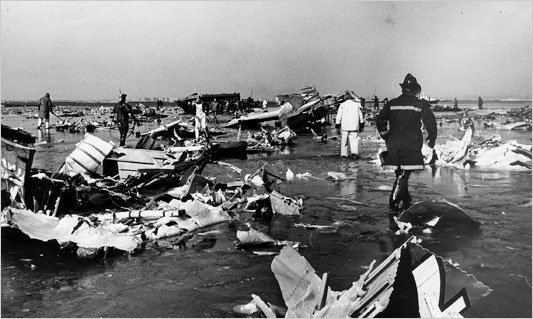 | ||
Summary Improper maintenance, manufacturing defect leading to mechanical failure Site Jamaica Bay, Queens, New York, United States Aircraft type Boeing 707-123B Astrojet Destination Los Angeles International Airport Locations United States of America, New York, Jamaica Bay, Queens Similar Continental Airlines Flight 11, Air France Flight 117, Air France Flight 007, American Airlines Flight 514, American Airlines Flight 320 | ||
American Airlines Flight 1 was a domestic, scheduled passenger flight from New York International (Idlewild) Airport (now John Kennedy International Airport), to Los Angeles International Airport. On March 1, 1962, the plane – having just taken off two minutes earlier – rolled over and crashed into a swamp, killing all 87 passengers and eight crew members aboard. A Civil Aeronautics Board (CAB) investigation determined that a manufacturing defect in the automatic pilot system led to an uncommanded rudder control system input, causing the accident. A number of notable people died in the crash. It was the sixth fatal Boeing 707 crash and, at the time, the deadliest.
Contents

American airlines flight 1
Flight and crash
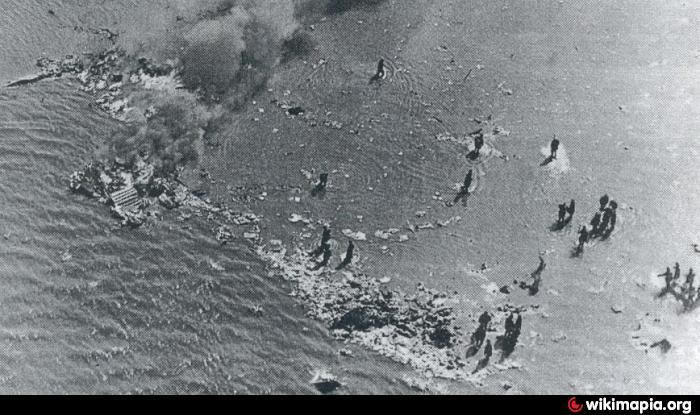
The aircraft was a Boeing 707-123B, U.S. Registry N7506A. It was delivered to American Airlines on February 12, 1959. At the time of the crash, it had accumulated 8,147 flight hours. Its last periodic inspection had occurred on January 18, 1962 at 7,922 hours of air time. The flight crew consisted of Captain James Heist, First Officer Michael Barna, Jr., Second Officer Robert Pecor, and Flight Engineer Robert Cain. Also aboard were four stewardesses: Shirley Grabow, Lois Kelly, Betty Moore, and Rosalind Stewart.
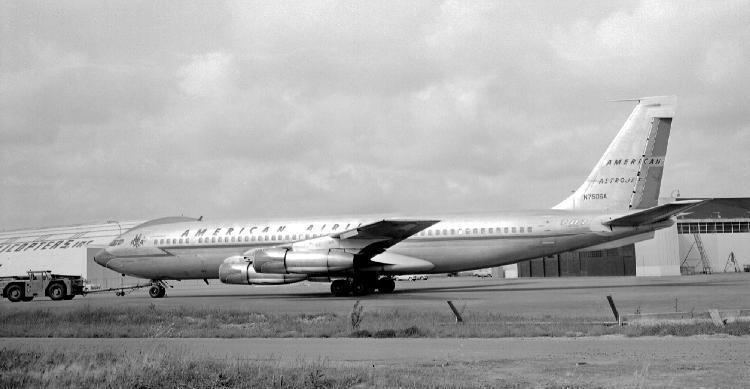
The aircraft received instructions to taxi to Runway 31L at 9:54 AM EST, and clearance to proceed to Los Angeles non-stop under instrument flight rules (IFR) at 10:02 AM EST. Flight 1 became airborne at 10:07 AM EST. Following American Airlines procedures and Departure Control instructions, the aircraft initiated a left turn to a heading of 290. In the course of the turn, at 1,600 feet, the Boeing banked too far, flipped past 90 degrees, and began an upside-down, nose-first descent in a nearly vertical dive.
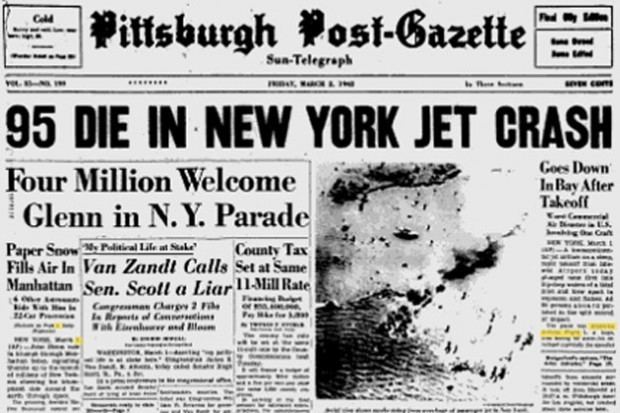
Flight 1 crashed into Pumpkin Patch Channel, Jamaica Bay, at 10:08:49, while angled at 78 degrees and on a magnetic heading of 300 degrees. Passengers aboard a Mohawk Airlines plane bound for Albany that took off immediately after Flight 1 watched the plane plunge into the bay. The jet exploded upon impact, a geyser of brackish water and black smoke erupted from the site, and the scattered debris and fuel caught fire. Long Island residents described hearing explosions which shook the foundations of nearby houses, though no one on the ground is known to have witnessed the plane hitting the swamp. However, a few men at Naval Air Station New York / Floyd Bennett Field saw the massive geyser of water rising above the hangars, and one guard—at his post on a bridge that the plane flew over—saw the plane roll over.
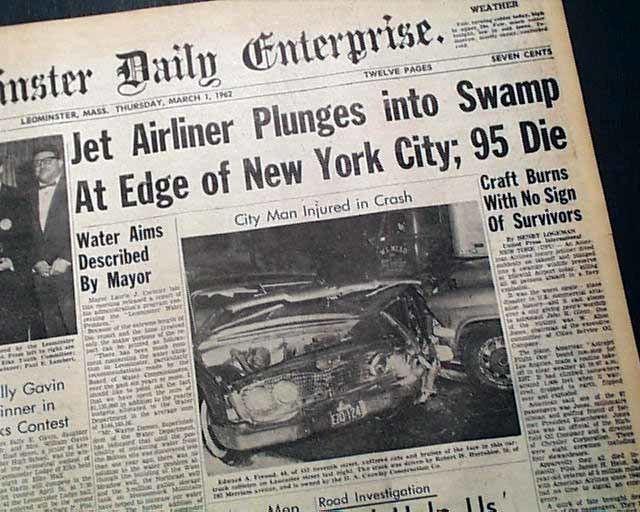
The aircraft crashed into a remote area of marshland on Jamaica Bay used as a wildlife sanctuary. Upwards of 300 policemen and fire fighters, including 125 detectives attending a narcotics seminar at the Police Academy, as well as Coast Guard helicopters were mobilized to the crash site within half an hour of the crash for rescue operations, only to find there were no survivors. The three-alarm fire was under control by 10:50 AM EST, by which point only wreckage remained. Low tides aided search personnel in their attempts to recover bodies from the downed aircraft. Only a few bodies remained intact.
Investigation
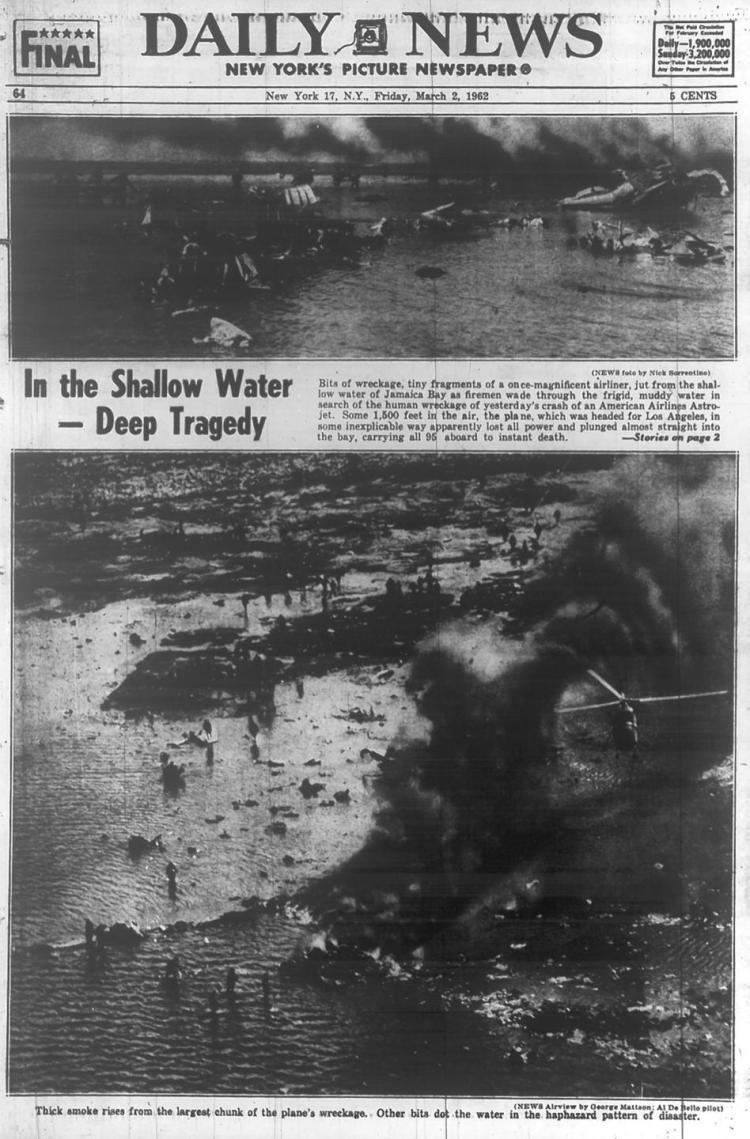
The Civil Aeronautics Board received notification of the accident at 10:10 AM EST and immediately sent investigators to Jamaica Bay to conduct an investigation. The flight recorder was found on March 9 and sent to Washington for analysis. Public hearings were held at the International Hotel in New York on March 20–23, 1962.

Investigators were unable to recover sufficient body tissue to determine whether the crew had been physically incapacitated at the time of the crash. Toxicology reports conclusively ruled out toxic gases, alcohol, and drugs as possible cause for the crash. Milton Helpern, Chief Medical Examiner, decided that having relatives attempt visual identification of the crash victims was inhumane and ordered dental and fingerprint comparisons. In early July, the CAB announced their investigators believed that a cotter pin and a bolt missing from the rudder mechanism might have caused Flight 1's crash. Though considered to be a "mechanic's oversight", the CAB nevertheless wired all 707 operators to inform them of the potential danger of the assembly.
In January 1963, the CAB released a Civil Aeronautics Board Aircraft Accident Report stating that the "most likely abnormality" to have caused the crash was a short circuit caused by wires in the automatic piloting system that had been damaged in the manufacturing process.
From the CAB's AAR, Pg 2, probable cause: "... rudder control system malfunction producing yaw, sideslip, and roll leading to a loss of control from which recovery was not effective."
From AAR pg 54: "The Board therefore concludes that a rudder servo malfunction due to shorted wires is the most likely abnormality to have produced the accident."
CAB inspectors had inspected units at a Teterboro, New Jersey, Bendix Corporation plant and discovered workers using tweezers to bind up bundles of wires, thereby damaging them. The Bendix Corporation issued denials, stating that the units underwent 61 inspections during manufacturing, in addition to inspections during installation and maintenance work, and insisted that had the insulation on the wires been breached at some point, it would have surely been detected and the unit replaced.
Notable victims
A number of notable people were aboard Flight 1 when it went down in Jamaica Bay. They included:
In addition, 15 abstract paintings by the artist Arshile Gorky that were en route to Los Angeles for an exhibition were destroyed.
In popular culture
The crash serves as a central plot element in the Mad Men season 2 episode, "Flight 1" (S2/e2). The father of the character Pete Campbell is one of the passengers killed. In a later episode, accounts man Duck Phillips is so determined to sign American as an account and so convinced of Pete's ambition, that he recruits Pete specifically to woo American, while insisting the firm cut all ties with competitor Mohawk. The ploy costs the firm all its airline business, as they drop Mohawk only to be spurned by American.
